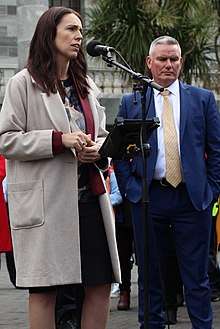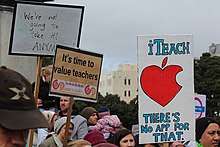New Zealand Educational Institute
The New Zealand Educational Institute (NZEI, in Maori: Te Riu Roa) is the largest education trade union in New Zealand. It was founded in 1883 and has a membership of 50,000.[1]
| Full name | New Zealand Educational Institute Te Riu Roa |
|---|---|
| Native name | Te Riu Roa |
| Founded | 1883 |
| Members | 50,000 |
| Affiliation | Education International |
| Key people | Liam Rutherford, President Paul Goulter, National Secretary |
| Office location | Wellington, New Zealand |
| Country | New Zealand |
| Website | www |
.jpg)
History
The NZEI was founded by a merger of district institutes of teachers in 1883[2] at a meeting in Christchurch. It quickly became the nationwide voice of primary school teachers. Since the 1994 merger with the Combined Early Childhood Union of Aotearoa (CECUA) it has also represented teachers in early childhood centres. Since the major New Zealand employment law changes in the 1980s and 1990s,[3] the NZEI negotiates the more than twenty collective agreements across the two sectors, including principals, teachers, support staff, te reo Maori immersion staff and Ministerial staff.[4]
Early childhood education
Due to the relatively fragmented history and nature of early childhood education in New Zealand, the largest number of collective agreements negotiated by the NZEI are in this sector.[4]
Primary schools
Primary staff and principals are on separate collective agreements, with separate agreements for area (rural) staff and principals, but these are negotiated together.[4]
Strikes

The NZEI has struck four times since it was founded in 1883.[5]

In 1991 members struck (unsuccessfully) as part of wider industrial and union action against the Employment Contracts Act 1991,[5] which lead to significant changes in New Zealand employment relations.[6]
Members struck in 1994 and 1995 to successfully achieve pay parity with the Post Primary Teachers' Association (PPTA),[5] their colleagues in secondary schooling. This related pay scales to the teachers' qualifications.[7]
Members struck in 2018 as part of the negotiation round with the Sixth Labour Government of New Zealand. Rallies and marches were held in the major cities.[5] In 29 May 2019, the NZEI and the PPTA stage a mega strike demanding higher salaries, rejecting the Government's three-percent pay rise offer.[8][9][10]
On 26 June 2019, primary school teachers voted to accept the Government's NZ$1.5 billion collective agreement. Key provisions of the collective agreement include a new pay scale, raising all teachers' base salaries by 18.5% by July 2021, and making Q3+, Q4, and Q5 teachers eligible for a new top salary of NZ$90,000. However, primary principals have rejected the offer, regarding the government's offer as insufficient.[11][12][13]
On 26 July, the New Zealand Educational Institute's early childhood teacher members voted to accept a collective agreement with the Ministry of Education that will put early childhood education teachers' pay on par with primary and secondary school teachers. As part of the terms, early childhood education teachers will receive a pay rise of at least 18.5% by July 2020, NZEI members will receive a lump sum of NZ$1,500, and there will be an increase in the head and senior teachers' allowances, and a new top step of NZ$90,000 for teachers. While the NZEI negotiates on behalf of all early childhood teachers in New Zealand, union members only make up 12.5% of the early childhood workforce in this country.[14][15]
References
- "About Us". New Zealand Educational Institute. Retrieved 26 June 2019.
- "Teachers' Organisations — Primary". An Encyclopaedia of New Zealand. 1966. Retrieved 19 August 2018.
- Olssen, Erik (11 March 2010). "Unions and employee organisations - Unions after 1960". Te Ara – the Encyclopedia of New Zealand. Retrieved 19 August 2018.
- "Primary Schools Collective Agreements". New Zealand Educational Institute. Retrieved 26 June 2019.
- "Teachers' strike today: School's out - All you need to know". The New Zealand Herald. 15 August 2018. Retrieved 19 August 2018.
- Derby, Mark (1 March 2016). "Strikes and labour disputes - Legislation from the 1990s". Te Ara - The Encyclopedia of New Zealand. Retrieved 26 June 2019.
- De Boni, Dita (22 August 2002). "Teachers' pay parity preserved, but writing on wall". New Zealand Herald. Retrieved 26 June 2019.
- "Live: Teachers on 'mega strike'". Radio New Zealand. Scoop. 29 May 2019. Retrieved 26 June 2019.
- Roy, Eleanor Ainge (28 May 2019). "New Zealand schools hit by 'mega-strike' as 50,000 teachers walk out". The Guardian. Retrieved 26 June 2019.
- "Teachers' mega-strike: What to do with your kids today". New Zealand Herald. 29 May 2019. Retrieved 26 June 2019.
- Williams, Katarina; Iles, Julie (26 June 2019). "Primary teachers say yes, principals say no to latest collective agreement offers". Stuff.co.nz. Retrieved 26 June 2019.
- Collins, Simon (26 June 2019). "Teachers accept pay deal - but principals reject it". New Zealand Herald. Retrieved 26 June 2019.
- "Proposed settlement for primary teachers". New Zealand Educational Institute. Retrieved 26 June 2019.
- Franks, Josephine (26 July 2019). "Kindergarten teachers vote to accept collective agreement, giving them pay parity". Stuff.co.nz. Retrieved 26 July 2019.
- "Kindergarten teachers accept new collective agreement". New Zealand Educational Institute. Scoop. 26 July 2019. Retrieved 26 July 2019.
External links
| Wikimedia Commons has media related to New Zealand Educational Institute. |